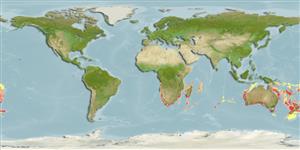Classification / Names
Common names | Synonyms | Catalog of Fishes (gen., sp.) | ITIS | CoL | WoRMS | Cloffa
Elasmobranchii (sharks and rays) >
Squaliformes (Bramble, sleeper and dogfish sharks) >
Centrophoridae (Gulper sharks)
Etymology: Deania: From B. Dean (1916), ichthyiologist and researcher of ichtyiological bibliography (Ref. 45335).
Environment / Climate / Range
Ecology
Marine; bathydemersal; depth range 150 - 1360 m (Ref. 44037), usually 400 - 820 m (Ref. 6871). Deep-water, preferred ?; 9°S - 54°S, 12°E - 172°W (Ref. 54349)
Southeast Atlantic: off Namibia and off Algoa Bay, South Africa. Indo-West Pacific: off southern Mozambique and Natal, South Africa; Australia and New Zealand (Ref. 6871).
Length at first maturity / Size / Weight / Age
Maturity: Lm ?, range 110 - ? cm
Max length : 115 cm TL male/unsexed; (Ref. 6871)
Dorsal
spines
(total): 2;
Dorsal
soft rays
(total): 0;
Anal
spines: 0;
Anal
soft rays: 0. Extremely long snout, grooved dorsal fin spines, compressed cutting teeth in both jaws, moderately large, pitchfork-shaped denticles, no subcaudal keel on underside of caudal peduncle, first dorsal fin short and high (Ref. 247). Dark brown, grey, or black in color; juveniles with a dark blotch on each dorsal fin (Ref. 26346).
A rare (Ref. 26346) and little-known species found on outer continental shelves and upper slopes (Ref. 247). Feeds on bony fishes (Ref. 247). Ovoviviparous (Ref. 50449).
Life cycle and mating behavior
Maturity | Reproduction | Spawning | Eggs | Fecundity | Larvae
Ovoviviparous, embryos feed solely on yolk (Ref. 50449). Distinct pairing with embrace (Ref. 205).
Compagno, L.J.V., 1984. FAO Species Catalogue. Vol. 4. Sharks of the world. An annotated and illustrated catalogue of shark species known to date. Part 1 - Hexanchiformes to Lamniformes. FAO Fish. Synop. 125(4/1):1-249. Rome, FAO. (Ref. 247)
IUCN Red List Status (Ref. 115185)
CITES (Ref. 94142)
Not Evaluated
Threat to humans
Harmless
Human uses
Fisheries: minor commercial
More information
ReferencesAquacultureAquaculture profileStrainsGeneticsAllele frequenciesHeritabilityDiseasesProcessingMass conversion
Tools
Special reports
Download XML
Internet sources
